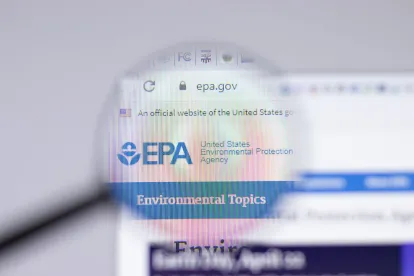The U.S. Environmental Protection Agency (EPA) has proposed changes to its Toxic Substances Control Act (TSCA) regulations dealing with premanufacture notices (PMNs) and certain exemptions from PMN requirements. Of particular note, EPA has proposed to codify its stated position that per- and polyfluorinated substances (PFAS) are ineligible for low volume exemptions (LVEs) and low release and exposure (LoREX) exemptions. EPA has also proposed to make persistent, bioaccumulative, and toxic (PBT) substances ineligible for these exemptions. EPA is also soliciting comments on whether to revoke previously-granted LVE applications for PFAS. In addition, EPA has proposed:
-
Updating regulations to reflect the 2016 Lautenberg Amendments to TSCA stating that EPA must make an affirmative determination on PMNs, significant new use notices (SNUNs), and microbial commercial activity notices (MCANs) – as well as LVE and LoREX applications – before the proposed activity can commence.
-
Updating regulations and EPA’s PMN form to specify the level of detail EPA expects as part of a notification.
-
Updating regulations regarding pre-screening processes, incomplete submissions, and new information for PMNs and other notifications.
EPA requests comments on these proposed changes by July 25, 2023.
Ineligibility of PFAS for LVE and LoREX Exemptions
EPA previously announced that it is unlikely that PFAS would henceforth be eligible for an LVE or LoREX. EPA is now proposing to make new PFAS categorically ineligible for these exemptions. EPA had also launched a “PFAS LVE Stewardship Program” that encouraged companies to voluntarily withdraw LVEs previously obtained for PFAS. In the current rulemaking, EPA has proposed to define PFAS for these purposes as a chemical substance that contains at least one of these three structures:
-
R-(CF2)-CF(R’)R”, where both the CF2 and CF moieties are saturated carbons;
-
R-CF2OCF2-R’, where R and R’ can either be F, O, or saturated carbons; or
-
CF3C(CF3)R’R’’, where R’ and R” can either be F or saturated carbons.
The proposed definition does not include substances with only a single fluorinated carbon or unsaturated fluorinated moieties because, in EPA’s view, these substances “are more susceptible to chemical transformation than their saturated counterparts, and therefore less likely to persist in the environment.” EPA stated that the first sub-structure listed above “has been the working definition of PFAS” used by the Office of Pollution Prevention and Toxics when identifying PFAS on the TSCA Inventory. For this definition, EPA proposes expanding the definition to include the two additional sub-structures, one to account for GenX substances and the other to include certain branched PFAS. The proposal would apply to fluoropolymers.
This proposed ineligibility would apply only prospectively, not to existing LVEs for PFAS. However, EPA is also soliciting comments on whether it should revoke previously-granted PFAS LVEs.
Ineligibility of PBTs for LVE and LoREX Exemptions
EPA is proposing amendments to its regulations to codify its practice that substances that EPA regards as persistent, bioaccumulative, and toxic are ineligible for the LVE and LoREX exemptions. EPA is proposing the following definition of “PBT chemical substance”:
"A chemical substance possessing characteristics of persistence (P) in the environment, accumulation in biological organisms (bioaccumulation (B)), and toxicity (T) resulting in potential risks to humans and ecosystems. For more information on EPA’s Policy on new chemical substances that are PBT, see EPA’s 1999 policy statement (64 FR 60194; November 4, 1999)."
EPA acknowledges that whether a chemical substance is a PBT would be determined by EPA on a case-by-case basis after the exemption application was submitted. A submitter, therefore, may not be able to determine in advance whether EPA would regard a chemical as a PBT.
Conforming Amendments to PMN Regulations to Reflect 2016 Lautenberg Amendments
EPA proposes updating its procedural regulations regarding PMNs to reflect the 2016 Lautenberg Amendments to TSCA. These procedural regulations also apply to SNUNs and MCANs. Following the 2016 Lautenberg Amendments, EPA must make affirmative determinations on:
-
A PMN before the manufacture of a new chemical may commence;
-
A SNUN before manufacture or process for a significant new use may commence; and
-
An MCAN before the manufacture of a new microorganism or manufacture or processing of a microorganism for a new use may commence.
The amendments would resolve what EPA views as inconsistencies between existing regulations and amended TSCA. Separately, EPA is proposing changes to its LVE and LoREX regulations to state that activities relying on these exemptions may not begin until EPA has acted on a submitter’s application.
EPA is also proposing to amend existing regulations to list the five possible determinations EPA may make, under amended TSCA, for each PMN, SNUN, or MCAN:
-
The new chemical substance or significant new use is not likely to present an unreasonable risk of injury to health or the environment, without consideration of costs or other non-risk factors, including an unreasonable risk to a potentially exposed or susceptible subpopulation identified as relevant by EPA under the conditions of use. If EPA makes this determination, it will publish such a “not likely” finding in the Federal Register.
-
The information available to EPA is insufficient to permit a reasoned evaluation of the health and environmental effects of the new chemical substance or significant new use. This determination requires EPA to issue a Section 5(e) order.
-
In the absence of sufficient information, the manufacture, processing, distribution in commerce, use, or disposal of the chemical substance may present an unreasonable risk of injury to health or the environment, without consideration of costs or other non-risk factors, including an unreasonable risk to a potentially exposed or susceptible subpopulation identified as relevant by EPA. This determination requires EPA to issue a Section 5(e) order.
-
The chemical substance is or will be produced in substantial quantities and may either enter the environment in substantial quantities or result in significant or substantial human exposure. This determination requires EPA to issue a Section 5(e) order.
-
The chemical substance or significant new use presents an unreasonable risk of injury to health or the environment without consideration of costs or other non-risk factors, including an unreasonable risk to a potentially exposed or susceptible subpopulation identified as relevant by EPA under the conditions of use. This determination requires EPA to either issue an immediately effective proposed rule under Section 6(a) or issue an order to take effect on the expiration of the applicable review period.
EPA is also proposing a regulatory definition of “potentially exposed or susceptible subpopulation” that is identical to the definition from the 2016 Lautenberg Amendments, except that it would add “overburdened communities” to the list of potentially relevant subpopulations.
Updating Regulations and PMN Form to Specify Level of Detail for PMNs
EPA is proposing updates to its regulations and the PMN form within its Central Data Exchange with the stated goal to encourage more detailed submissions. EPA has observed that PMN submissions (as well as related submissions such as SNUNs and test marketing exemption applications) are often amended by the submitter to include additional detail subsequent to the original notification. EPA proposes adding informational requirements regarding physical and chemical properties; environmental fate characteristics; categories of use; details concerning manufacture, processing, and use; worker exposure; environmental releases; and pollution prevention information. EPA seeks comments on its burden estimate and general pros and cons for these proposed changes.
Section 5(d)(1)(A) of TSCA assures that submitters need only submit information “known to or reasonably ascertainable” by them. Thus, for many of the data elements proposed to be added, submitters may have no information to provide. However, commenters may want to ask EPA to clarify what “reasonably ascertainable” means (beyond the regulatory definition) in the context of PMNs, such as to what extent submitters must reach out to prospective customers for their information.
Amendments Related to Pre-Screening Processes, Incomplete Submissions, and New Information
EPA also proposes amendments to its regulations to account for its pre-screening process and how an incomplete submission, or the submission of new information, affects EPA’s timing deadlines. EPA’s review of a notice currently begins with a 2-3 day pre-screen process. If EPA deems the notice to be unnecessary (e.g., a PMN for a chemical substance already on the Inventory) or incomplete, EPA will notify the submitter and the applicable review period will not begin until a complete notice is submitted. EPA is proposing regulatory text to codify this pre-screening process. EPA is also proposing language that if it concludes within 30 days after submission that a notice contains errors, EPA will notify the submitter and the applicable review period will not begin until the submitter corrects the errors. EPA is also proposing language stating that if the submitter submits new information that was “known to or reasonably ascertainable” by the submitter at the time of the original submission, EPA may restart the applicable review period upon submission of the new information.





 />i
/>i

